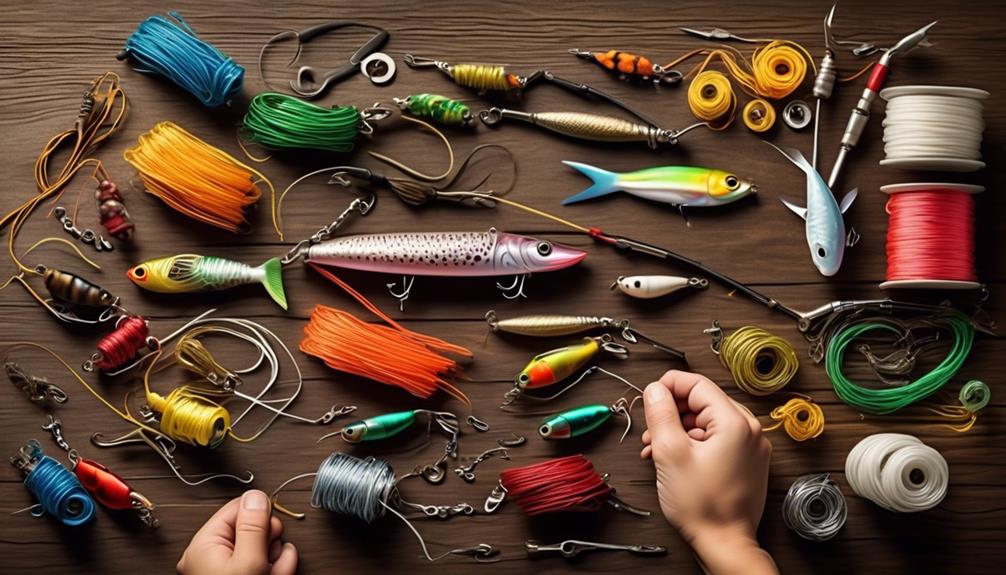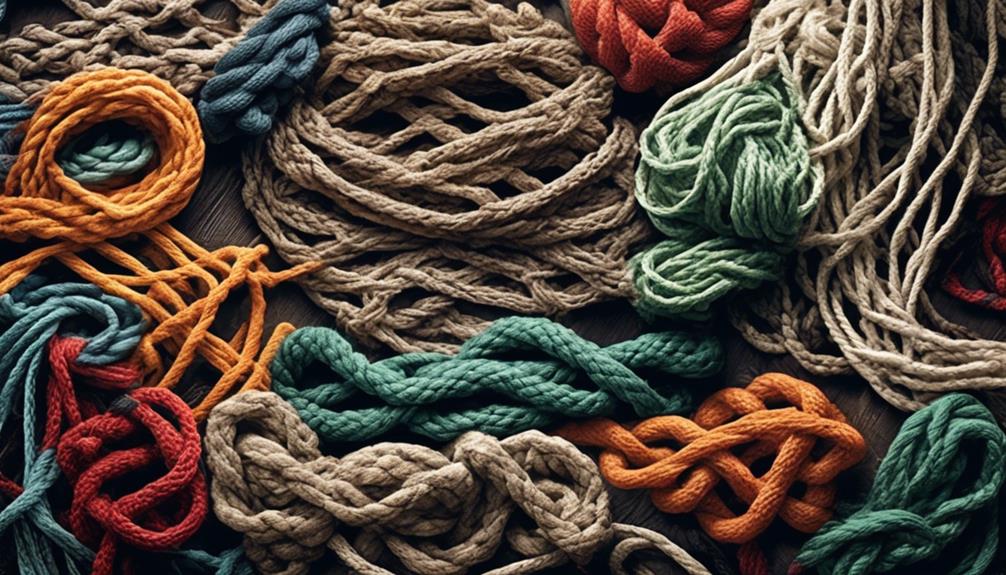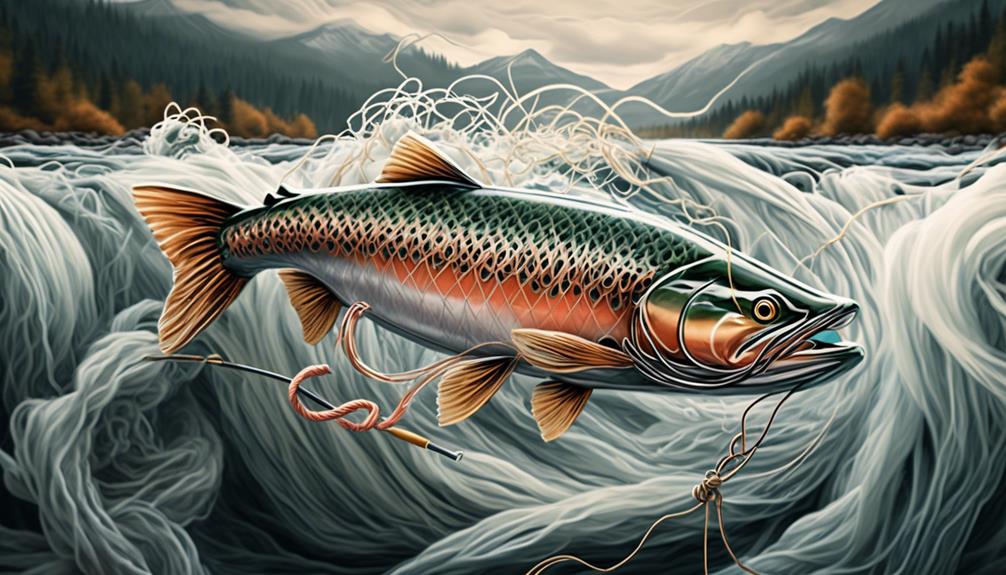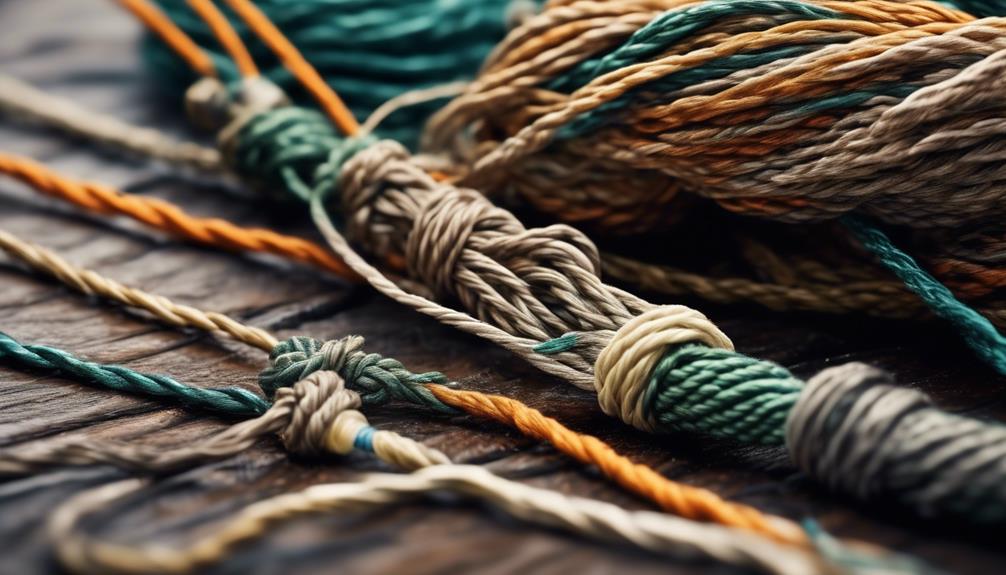You know the frustration of losing a prized catch due to a poorly tied knot. It's a common struggle for many anglers, and finding the right knot for lure attachment can make all the difference.
With several options available, it's essential to understand the strengths and weaknesses of each knot so that you can confidently secure your lure and focus on reeling in the big one.
So, let's explore the top fishing knots for lure attachment and how they can elevate your fishing game.
Improved Clinch Knot
To tie the Improved Clinch Knot, follow these simple steps for a secure and reliable lure attachment. This knot is known for its exceptional knot strength and is one of the essential knot tying techniques every angler should master.
Start by threading the line through the eye of the hook and then double back parallel to the standing line, creating a simple loop. Next, twist the tag end around the standing line at least five times. Remember to ensure that the coils are neat and in a spiral formation.
After the twists, pass the tag end through the loop you created behind the hook eye. Then, bring the tag end back through the large loop formed at the beginning of the twists. Wet the knot with some water or saliva to reduce friction and pull the tag end to close the knot. Trim any excess tag end to finish the knot.
The Improved Clinch Knot is renowned for its exceptional knot strength, ensuring that your lure stays securely attached during intense battles with feisty fish. Its reliability and ease of tying make it a favorite among anglers.
Palomar Knot
The Palomar Knot is a highly reliable and simple knot for attaching lures, making it a popular choice among anglers of all skill levels. Its strength is one of its key advantages, as it retains a high percentage of the line's original strength when tied correctly. This knot is particularly well-suited for braid fishing lines due to its ability to maintain strength and integrity when used with this type of line.
When tying the Palomar Knot, it's important to double the line before passing it through the hook eye or lure. This double line is then used to form a simple overhand knot. Next, the hook or lure is passed through the loop, and the entire knot is moistened before being drawn tight. This straightforward process contributes to the knot's popularity among anglers.
The Palomar Knot's strength is a significant factor in its widespread use. It's known for its ability to maintain nearly the full strength of the line, making it a dependable option when attaching lures. Additionally, its reliability with braid fishing lines adds to its appeal for anglers seeking a versatile knot that can be used across different types of fishing setups.
Whether you're a beginner or an experienced angler, the Palomar Knot is a valuable addition to your repertoire of fishing knots.
Uni Knot
When tying the Uni Knot, ensure that the tag end of the line is long enough to work with comfortably.
The Uni Knot, also known as the Hangman's Knot, is a versatile and reliable knot used for attaching lures, hooks, and swivels to the fishing line. One of the advantages of the Uni Knot is its simplicity, making it easy to tie even in low light or adverse weather conditions. Additionally, this knot retains a significant amount of the line's original strength when tied correctly. However, a potential disadvantage of the Uni Knot is that it may slip if not cinched tightly enough, so it's crucial to ensure proper tightening when using this knot.
Comparing the Uni Knot to other popular knots, it offers several distinct advantages. Unlike the Palomar Knot, which can be challenging to tie with lines of varying diameters, the Uni Knot is more adaptable and can be used with different types of fishing lines. Furthermore, the Uni Knot is generally easier to tie than the Double Uni Knot and serves as a reliable option for securing the connection between the line and the lure.
Rapala Knot
One of the most effective knots for attaching lures is the Rapala Knot, renowned for its reliability and simplicity. When it comes to securing your lure, the Rapala Knot offers several advantages over other knots. Here's why it's an excellent choice:
- Rapala Knot Strength: The Rapala Knot is known for its exceptional strength. It retains a high percentage of the line's original breaking strength, giving you the confidence to tackle large game fish without worrying about the knot failing under pressure.
- Simplicity: One of the key benefits of the Rapala Knot is its simplicity. It's easy to tie, even in low light conditions or when dealing with fine or slippery lines. This simplicity makes it a favorite among anglers who value efficiency and reliability on the water.
- Versus Improved Clinch Knot: While the Improved Clinch Knot is a popular choice for attaching lures, the Rapala Knot often surpasses it in terms of strength. The Rapala Knot's ability to maintain line strength under pressure gives it an edge over the Improved Clinch Knot, especially when targeting larger, hard-fighting species.
- Adaptability: The Rapala Knot is versatile and can be used with a wide variety of lures. Whether you're attaching a crankbait, spinner, or spoon, the Rapala Knot provides a secure connection, allowing your lure to move naturally in the water, increasing its effectiveness in attracting fish.
Double Uni Knot
To tie the Double Uni Knot for lure attachment, start by overlapping the ends of the lines you want to connect. Create a loop with the end of the first line, then bring the tag end of the second line through the loop and wrap it around both lines and through the loop 4-6 times. Moisten the knot and pull it tight by sliding the wraps together.
Repeat the process with the second line, wrapping it around the first line and pulling it tight. Trim the tag ends, and you have a secure Double Uni Knot ready for lure attachment.
The Double Uni Knot is known for its exceptional knot strength and is versatile in various fishing applications. It's commonly used to attach lures, swivels, and hooks to the main fishing line. This knot is particularly useful when connecting lines of different types and diameters, making it essential for anglers who need to join monofilament or fluorocarbon leaders to braided lines.
When using the Double Uni Knot, it's important to consider the types of fishing lines and their compatibility. This knot is suitable for joining lines of varying materials and diameters, such as monofilament, fluorocarbon, and braided lines. Its ability to securely connect different lines makes it a valuable asset in a wide range of fishing scenarios.
Mastering the Double Uni Knot will enhance your angling experience and give you confidence in the strength and reliability of your connections.
Non-Slip Loop Knot
Having mastered the Double Uni Knot for lure attachment, you can now explore the Non-Slip Loop Knot, another essential knot for securing lures and enhancing your fishing experience. The Non-Slip Loop Knot is particularly useful when you want to allow a lure or fly to move more naturally in the water. Here's why you should consider incorporating the Non-Slip Loop Knot into your fishing repertoire:
- Knot Strength: The Non-Slip Loop Knot is known for its exceptional strength, making it a reliable choice for securing lures. Its design distributes the strain along the line evenly, reducing the risk of breakage when battling strong fish.
- Applications for Non-Slip Loop Knot: This knot is highly versatile and can be used with a wide range of lures, including plugs, spoons, and soft plastics. Its ability to create a free-swinging loop enhances the action of the lure, making it more enticing to fish.
- Ease of Tying: Despite its impressive strength, the Non-Slip Loop Knot is relatively easy to tie once you get the hang of it. With a bit of practice, you'll be able to tie this knot quickly and efficiently, saving you valuable time on the water.
- Improved Lure Action: By allowing the lure to move more naturally, the Non-Slip Loop Knot can increase your chances of attracting fish, especially in situations where a lifelike presentation is crucial.
Incorporating the Non-Slip Loop Knot into your angling arsenal can elevate your fishing game, providing you with a reliable and versatile option for securing various types of lures.
San Diego Jam Knot
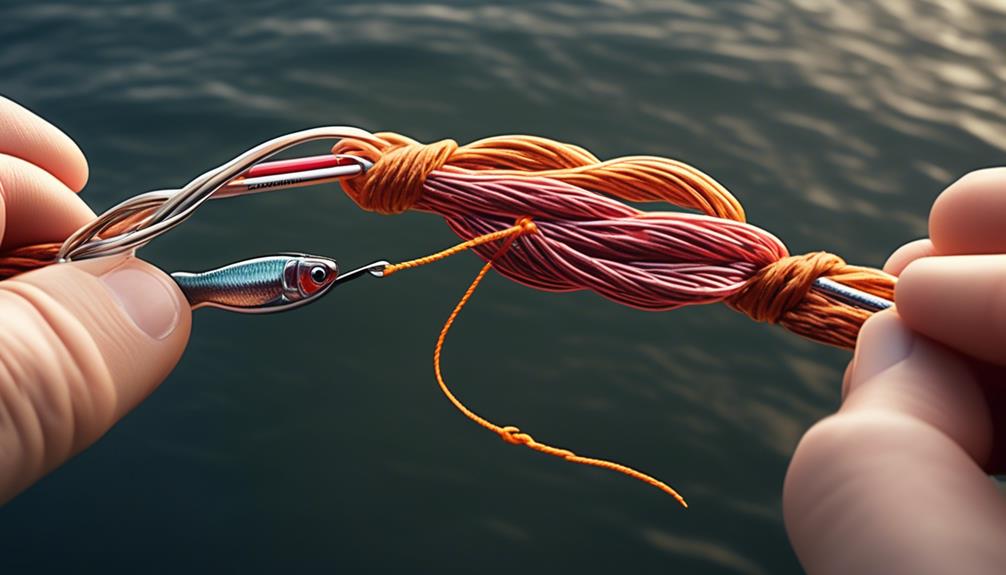
The San Diego Jam Knot is a reliable and popular choice for securing fishing line to hooks or lures. Its strength is one of the key reasons why it's favored by many anglers. This knot is known for its exceptional strength, making it suitable for various fishing conditions. Whether you're targeting large game fish or smaller species, the San Diego Jam Knot provides the confidence that your line will hold up during intense battles.
One of the primary applications of the San Diego Jam Knot is attaching hooks or lures to the line. Its ability to maintain a high level of strength even when subjected to sudden bursts of force makes it ideal for securing heavy lures or hooks. Additionally, the knot is relatively easy to tie, adding to its appeal for anglers of all skill levels. When you're out on the water, the last thing you want to worry about is the reliability of your knots, and the San Diego Jam Knot provides the peace of mind you need to focus on the thrill of the catch.
Moreover, the knot's strength is particularly advantageous when fishing in environments with rough structures, such as rocks or reefs, where the line may encounter abrasive surfaces. Its ability to withstand such conditions makes it a go-to choice for anglers targeting species that seek refuge in these challenging areas.
Loop Knot
Consider using a loop knot when you need to create a secure and versatile attachment point for your fishing lure. This type of knot allows for increased movement of the lure, which can enhance its action in the water and potentially attract more fish.
Here are some advantages and disadvantages of using a loop knot, as well as the different lure types it's best suited for:
- Advantages of Loop Knot
- Provides increased lure movement, which can attract more fish.
- Allows the lure to move more naturally in the water, mimicking live bait.
- Offers versatility, as it can be used with a wide range of lure types.
- Enhances the action of the lure, making it more enticing to fish.
- Disadvantages of Loop Knot
- Can be more complex to tie compared to some other knots.
- May require more practice to master tying this knot efficiently.
- Loop Knot for Different Lure Types
- Ideal for attaching crankbaits and jerkbaits, as the increased movement can mimic injured or fleeing baitfish.
- Well-suited for soft plastic lures, allowing them to move more freely and naturally in the water.
- Effective for topwater lures, enhancing their action and increasing their appeal to predatory fish.
- Suitable for spinnerbaits, enabling the blades to spin more freely and produce better underwater vibration.
Frequently Asked Questions
What Are the Best Types of Lures to Use With Each of These Knots?
When choosing lures for different knots, consider their size, weight, and action.
For example, a Palomar knot works well with a variety of lures, especially larger ones. It's strong and easy to tie, making it ideal for crankbaits and jigs.
On the other hand, a loop knot allows smaller lures to move more freely, enhancing their presentation.
Matching the right knot with your lure can improve your fishing technique and increase your catch.
Can These Knots Be Used for Saltwater Fishing as Well as Freshwater Fishing?
Yes, these knots can be used for saltwater fishing as well as freshwater fishing. The differences between saltwater and freshwater fishing techniques make some knots more advantageous in certain environments.
While some knots may be stronger in saltwater due to the corrosive nature, others may be more suitable for freshwater due to their ability to maintain strength.
Understanding these differences can help you choose the best knot for your fishing needs.
Are There Any Special Techniques or Tips for Tying These Knots in Windy or Rainy Conditions?
When tying knots in adverse weather conditions, ensure the knot strength by using proper techniques. Adjust your approach based on the lure types and line compatibility for the best results.
Consider the fishing environments and the challenges they present to maximize knot effectiveness. Keep in mind the specific requirements for saltwater and freshwater fishing.
Stay focused and steady-handed to overcome the challenges posed by windy or rainy conditions.
Can These Knots Be Used With Braided Fishing Line, or Are They Best Suited for Monofilament Line?
Yes, these knots can be used with braided fishing line, but they may be best suited for monofilament line due to their knot strength and the way they tie with braided line.
It's important to consider the type of line you're using to ensure the knot holds up.
When tying these knots with braided line, make sure to use the proper techniques to maintain their strength and reliability.
Are There Any Specific Types of Fish or Fishing Conditions Where These Knots May Not Be as Effective?
When selecting lures and considering fishing rod action, it's crucial to match the knot to the conditions. Factors like fish behavior and environmental conditions can affect knot effectiveness.
In fast currents, opt for knots that offer better strength and security. Similarly, when targeting larger or more aggressive fish, use knots that can handle the pressure.
Always consider the specific fishing conditions and the behavior of the fish when choosing the right knot for lure attachment.
Conclusion
Now that you've learned about the top fishing knots for lure attachment, you're ready to hit the water with confidence.
Whether you're using the Improved Clinch Knot or the Non-Slip Loop Knot, these essential knots will ensure that your lure stays secure and your fishing experience is a success.
So grab your gear and get ready to catch some big ones!
